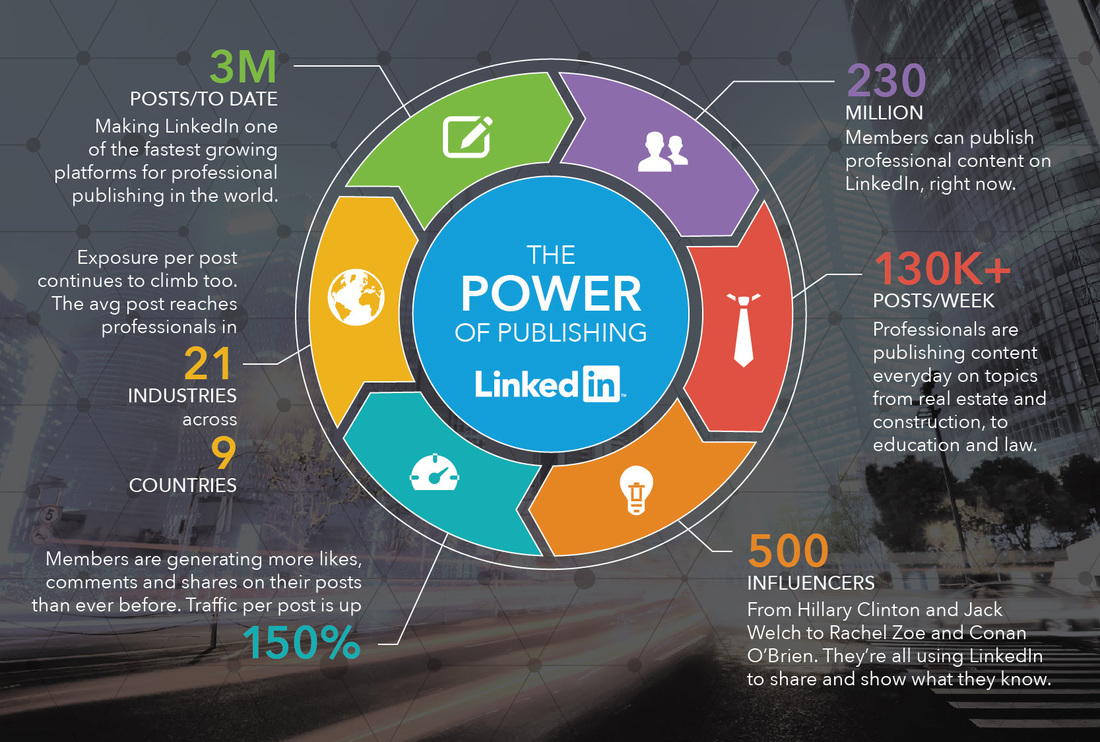|
Linkedin's blog just published the article below and infographic touting why you should publish on Linkedin. Here is why you should not limit your content sharing to Linkedin and why having your own blog/website is an idea whose time is way overdue. In fact, Linkedin is not the "best" place to publish, it is one of many good choices and some are better. Here's why:
Why Linkedin is the Best Place to PublishYou have s,omething to say, but finding the right platform for your content is as important as what you have to say. If you’re a professional with a valuable perspective to share, you have to find the audience it will resonate with – the audience you can invite along for the ride. It’s that perspective that makes you unique – and that ability to spark conversation among your peers that can take you far. Just as you bring it to the table each day to work for your company, your platform can and should be working for you.
We know there are plenty of places to share your thoughts on everything from top food destinations around the world to top tips for getting the best manicure– but for content for that is relevant to professionals, LinkedIn is the only platform where the audience you want to reach is waiting for you, and wants professional content. Other sites have content in search of an audience but LinkedIn has an audience in search of content (in fact, more than 360 million professionals worldwide), and with it, you have the ability to speak directly to the people you want to reach. What does that mean for you? It means that publishing on LinkedIn can have a direct impact on you as a professional, like those experienced by Janet Matta, who landed her dream job in a new country thanks to a series of events that started with a post on salary negotiation , or Robbie Abed, who met his professional idol and mentor following a wildly crazy post he did on LinkedIn about how he took 250 coffee meetings in 400 days. You have the opportunity to reach other professionals from around the world – senior leaders, potential clients, employers, partners, mentors and more – the people that can impact your bottom line or have an impact on your career. The audience is here, and they are looking for the content, the thought leaders, the tips to help them grow in their careers — you as the writer, can be that expert. In fact, on average, posts on LinkedIn see 6x the views from people outside of your immediate network. That can translate to huge opportunity. Here’s how: But it doesn’t stop there–you can also see what impact you’re having. Once you’ve published on LinkedIn, check out your post analytics to see who read, shared, or commented on your post, plus important insights on the industries and regions your readers come from, their level of seniority, and how they found you. Leverage those insights to help tailor your message, share it with your network, and let the power of LinkedIn and your network get your content in front of the people that actually matter to you most. Share your perspective, build your professional brand, and let your voice be heard – most importantly, make sure it’s being heard by the professionals that matter to you. Find the blog here
12 Comments
8/7/2015 08:17:31 am
Reply
11/5/2015 12:21:50 pm
I am 100% at your back for this road safety forum you are having. It's a great way of instilling to the people the value of safety when on the road and thus, preventing any accidents from happening. In our country, the rate of minor road accidents seems to rise so this forum would be helpful especially if attended by people mainly using the road for transportation.
Reply
12/4/2015 02:05:15 am
I can say this is the perfect blog for everybody who read and post here everyday. I dont know why I always visit here maybe its so nice to read here a interesting topics all day. So ill be back more to check more updates and new comments.
Reply
8/14/2019 05:38:15 am
Reply
8/14/2019 05:39:05 am
Reply
8/14/2019 05:39:56 am
Reply
8/4/2023 01:41:37 am
Weight loss is a common subject of interest for many people looking to improve their health and well-being. There are various approaches to weight loss, such as diet modifications, exercise, and lifestyle changes. If you have any specific points or questions you'd like to discuss regarding weight loss, feel free to share, and I'll be more than happy to assist you with information and insights.
Reply
9/18/2023 09:10:22 pm
This article gives the light in which we can observe the reality. This is very nice one and gives indepth information. Thanks for this nice article. https://www.deccanherald.com/brandspot/sponsored-health/ntx-keto-bhb-gummies-reviews-is-it-worth-trying-is-legit-2683034
Reply
11/5/2023 08:52:11 pm
Thank you for another great article. Where else could anyone get that kind of information in such a perfect way of writing? I have a presentation next week, and I am on the look for such information.
Reply
I am glad to read this post, it’s an impressive piece. I am always searching for quality posts and articles and this is what I found here, I hope you will be adding more in future
Reply
Excellent post. I was checking constantly this blog and I’m impressed! Extremely useful info particularly the last part I care for such information much. I was looking for this particular information for a long time. Thank you and good luck.
Reply
Thank you for such a well written article. It’s full of insightful information and entertaining descriptions. Your point of view is the best among many.
Reply
Leave a Reply. |
Categories
All
Archives
May 2019
Licensed by CC-by-SA
|
